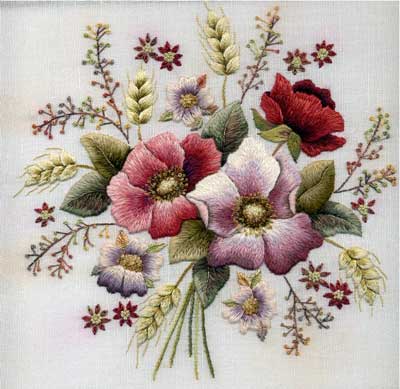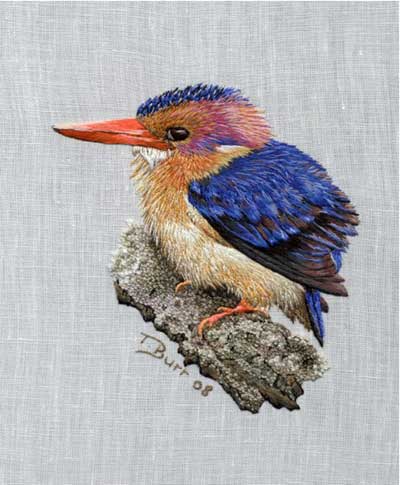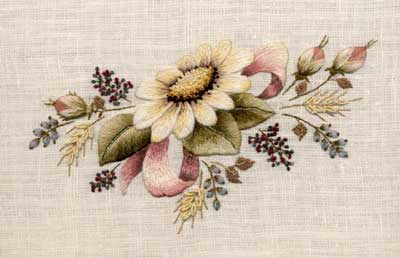Yesterday, I covered the first part of Trish Burr’s “interview” (really, her introduction notes for a class she is teaching), and featured some of her beautiful embroidery. I’d like to share with you the rest of her story and a couple more photos. If you haven’t read the first half of her story or seen the photos of her work, do check them out! In the meantime, on to Part 2 of Trish’s story.
I’m going to let Trish do the “talking” here and keep my big mouth shut! Enjoy!
The next book was Long and Short Stitch Embroidery: A Collection of Flowers, published in 2006. In 2004, we decided to make the move to Cape Town, so along with packing boxes and the new school uniforms came the plans for the next book! I decided to do a book on the technique of long and short stitch. I had begun a master craftsman course with the EGA so that I could teach when we got to South Africa, and it became apparent from my students that people were nervous of long and short stitch, so I resolved to make it plain. The publishers were not keen on text books; they wanted another project book, so I decided to combine the two.
I remembered how frustrated I had felt with the instructions in the books that I had learnt from. They give you the basic outline but left out those vital tidbits like how to achieve a smooth blending or what to do when working a difficult shape, so I spent the next two years researching this technique. I got onto my e-mail and contacted experts from all over the world who were kind enough to pass on their pearls of wisdown.
I tried to put myself in the shoes of someone who would be trying to learn from this book and decided to cover every aspect of long and short stitch from beginning to advanced.
There seemed to be a lot of confusion in the different interpretations, such as silk shading, soft shading, needle painting, etc. The Chinese used the hidden stitch method for hundreds of years, but the Western world has adapted this by splitting the yarn, and this is the commonly used technique today.

Long and short stitch is used to fill a shape with softly blended colours. If you are using it for Jacobean work or decorative surface stitching, it is usually used to shade from, say, pale pink to dark pink, but if you are using it in needle painting for a realistic effect, it is quite different and becomes more like staggered satin stitch.
When I was doing Redoute, I used padding to give a realistic 3-D effect, but I have changed my thoughts on this and now use contrast in color to give the same effect. This is a much simpler and faster way to work.
The first 50 pages of this book [Long and Short Stitch] tells you everything you need to know about the technique with step-by-step guidelines and a troubleshooting section, and then there are 21 projects from beginners to advanced. The paintings for the projects were used with permission from various Botanical artists. The book was reviewed and endorsed by Sally Saunders of the Royal School of Needlework before it was published and is now the text book for my classes.
The last book was Crewel and Surface Embroidery: Inspirational Floral Ideas. When the publishers asked me to come up with another title, I was lost for ideas – I supposed you could say I had writer’s block. My long suffering family supported my efforts as I ploughed through books, paintings, and the internet trying to come up with novel ideas.
By now I had joined the Helderberg embroidery guild and became aware of all the wonderful ways that embroidery could be expressed…

Space dyed and variagated threads were becoming very popular, but I was convinced that these could not be used for long and short embroidery… However, I proved myself wrong and found a way of incorporating some of the softly blended space dyed threads into long and short stitch.
I came across some decorative painting pictures of floral sprays by Gretchen Cagel in the US and with her permission based my designs on these. The result was a mix of thread painting and Australian wool embroidery. I combined wools, silks, and cottons together and created semi-realistic floral bouquets. The designs are fun to do and not too taxing!
There are three sections [in the book], one for beginners, intermediate, and advanced. Each section has step by step instructions and lists DMC and Appleton wool alternatives for all the threads used. This book has just been released…

A Bit on Book Publishing: Publishing has advanced dramatically in the last few years and I have had to keep up with these demands by learning computer illustrating and photographic editing. Books have become more visually oriented with enlarged photographic details and computer drawn illustrations that are lifelike. The reader wants fewer words and more pictures. Fortunately, the publishers have a professional who photographs the finished stitching because I am hopeless at taking photographs – I generally chop off people’s heads or shoot the background instead!!
Editing: There is a specialist editor who proof reads my work and goes through the project instructions with a fine tooth comb, so I don’t need to know how to spell! I do all the stitching and instructions myself and am required to do a minimum of 17 projects for a book. I am given advance payment which covers the cost of my materials. The entire process from start to delivery of the manuscript takes about a year and then another 6 months for editing and printing.
Sales: I have nothing to do with the sales of the book. The publishers distribute the book worldwide through their agents – although we do seem to have some problems in this regard to South Africa. If an author is lucky enough to go into a reprint in the first three months, it is considered to be selling well and there is always a chance that it could be translated into other languages, in which case the book exceeds its estimated print life. My last book was translated into Russian and Polish (not the upper scale of the market, but nevertheless….)
Royalties: I get a token royalty on each book that is sold. It is hard work and the returns are modest: it certainly doesn’t pay the bills, but there is something to be said for seeing all that hard work in print and knowing that what you set out to do has been achieved and will hopefully benefit others.
I would like to conclude by saying that books are a wonderful way of sharing your knowledge with others. We need to keep hand embroidery alive, and if we can’t share our ideas, if we hug them to ourselves, then they become lost and are worthless in the future.
If I give you a present, then I no longer have the gift – you do. But if I give you an idea, then we both have it – and if you give it to someone else and they share it with others, we have multiplied that idea.
If any of you have an idea to share, consider writing a book – you never know where it might lead you!
And there you have Trish’s words on where she’s been and how she got there! I hope you enjoyed reading her take on publishing needlework books, her tidbits of information on techniques, and her beautiful project samples as much as I did!







Dear Mary:
Thank you so much!! by this complete article, that I like very, very much!
A kiss
I enjoyed this very very much – and can’t wait to get the new book!
Thankyou so much for this,
Mary, now I’ve read about Trish, I’ll be sure to look out for her books. Her bird designs are just amazing, so realistic and well done that I could see some of the pages framed up on my walls quite easily, VBG. Not a technique I’ve
really tried, but these books might just spur me on to have a go.
Thanks for sharing, and
Hooroo,
Christine.
I already have Trish first two books and absolutely love them. I will make sure that I soon order her third one at Amazon. Too bad that it won’t be available before beginning of August, but the book is certainly worth the wait as I thought that the first two were so well written and had such inspiring projects in them.
I still need to find the time to make at least one of Trish’s projects.
Pierrette =^..^=
Pierrette =^..^=
that kingfisher is just beautiful! it looks like he’s ready to fly off the fabric! thanks for sharing!
NorseArcher, MA, USA
Would you be interested in publishing a tatting book? I can write articles, have pictures of my tatting items. I can write the book so beginners can understand tatting.
Felicidades sus bordados son maravillosos solo tengo el libro de bordado para principiante me encanto me gustaria recibir mas informacion sobre sus bordados.
Trabalho fantástico! Lindo trabalho!